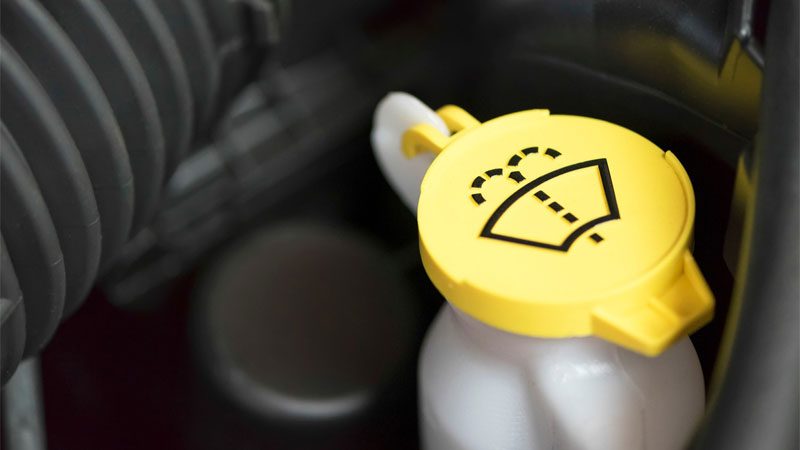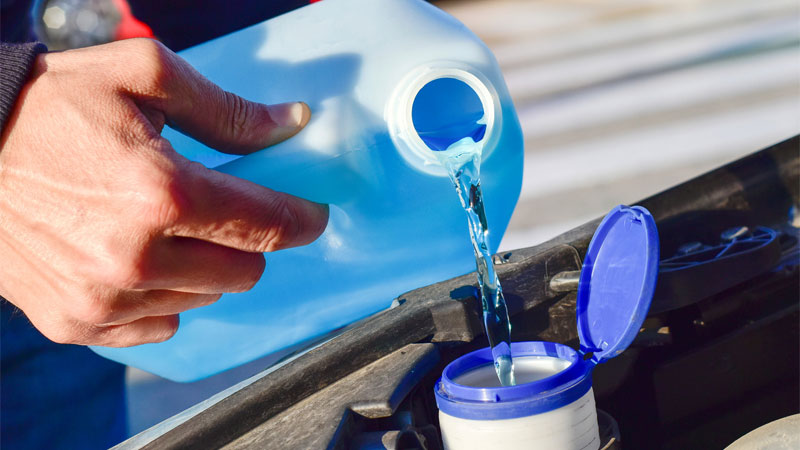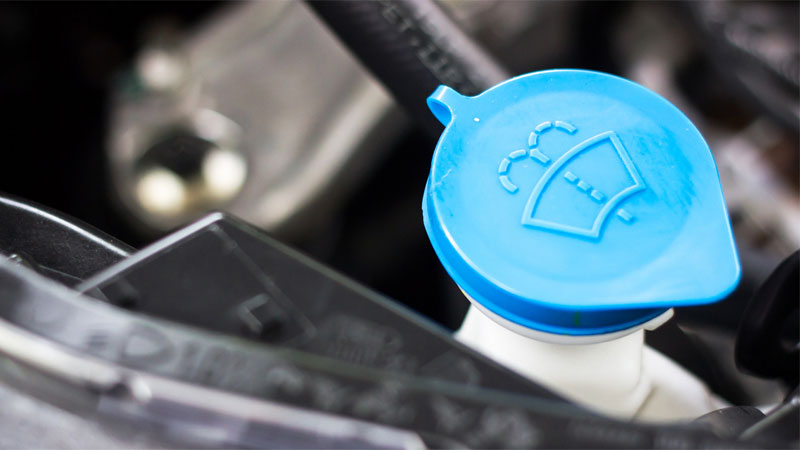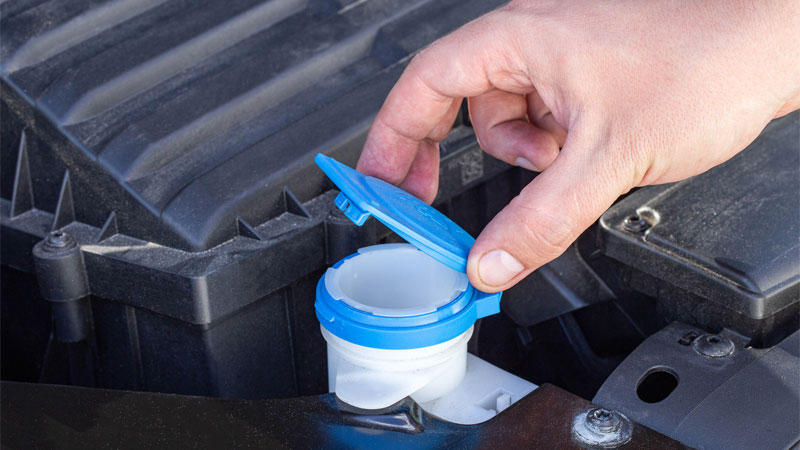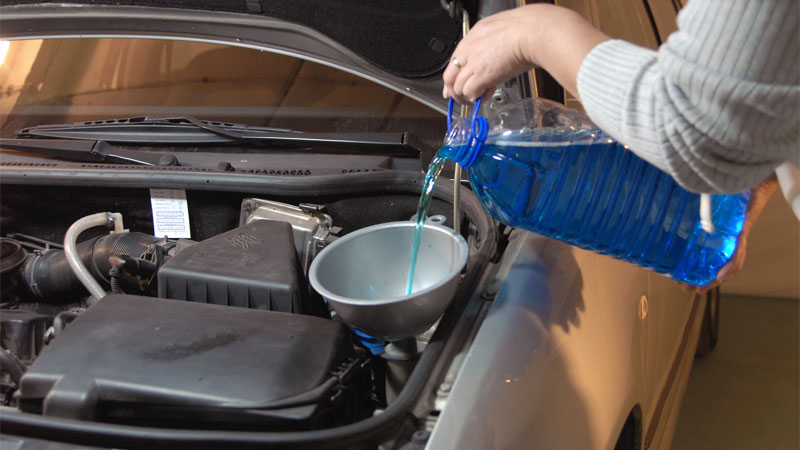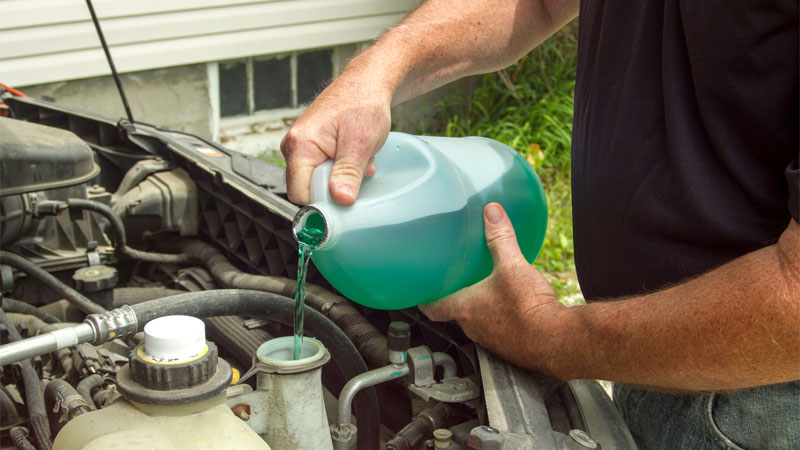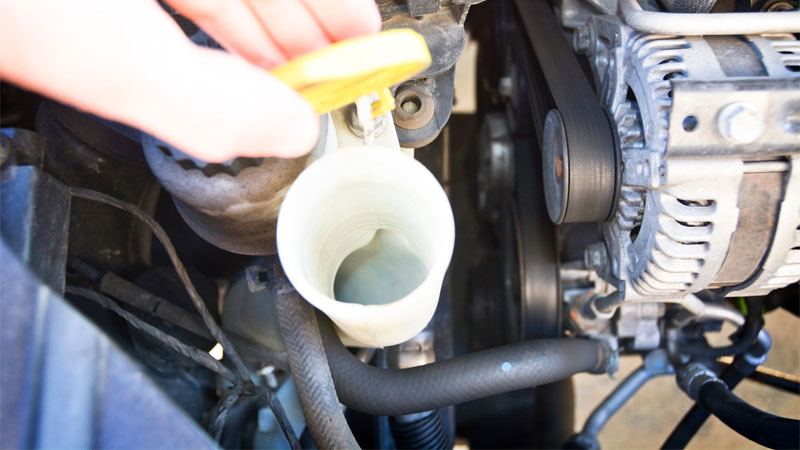Are you tired of driving around with a filthy windshield, trying to peer through a smeared and bug-splattered view?
Knowing how to refill your windshield washer fluid is something every driver should know and it’s often faster than finding and asking someone else to do it.
Not only is it an easy and affordable way to keep your windshield clean, but it’s also a great excuse to show off your DIY skills and impress those around you (ok, maybe not but it’s still a good skill to have). Here’s how…

How to Refill Windshield Washer Fluid
1. Gather Necessary Supplies
Before you begin, gather the necessary supplies, such as a jug of windshield wiper fluid, a funnel, and a rag. Ensure you’re using the appropriate fluid, as some vehicles require specific types.
Don’t have any wiper fluid on hand? Here are some good places to buy washer fluid at.
2. Park the Car on a Level Surface
Park your car on a level surface to prevent the wiper fluid from spilling when you pour it into the reservoir. A flat surface makes it easier to accurately gauge how much fluid you’re adding and the amount of washer fluid a car holds varies from one vehicle to another so check your owner’s manual.
3. Allow Engine to Cool
If possible, you’ll want to wait for your vehicle’s engine to cool down before proceeding. Handling parts of the engine while it’s hot can result in burns or other injuries, especially when a wiper fluid reservoir is located in a not-so-easy-to-reach location. Once the engine is cool, you’re ready to continue.
4. Open the Hood
Locate the hood release lever, typically found under the dashboard or on the side of the driver’s door. Pull the lever to release the hood latch and head to the front of your car.
Carefully lift the hood and secure it with the hood prop rod if it isn’t equipped with hydraulic hood supports. You’re now prepared to refill the windshield wiper fluid.
5. Locate the Reservoir
To find the washer fluid reservoir, first look in the engine bay. You’ll find a container with a clear or translucent body and a cap, often labeled with a windshield/wiper symbol or a similar icon. It’s normally located on either side of the engine, but its exact placement varies between different car models.
6. Check for Leaks and Cracks
Before refilling your washer fluid, inspect the reservoir for visible signs of leaks or cracks as that may be the reason you’re out of fluid. If it’s damaged, you might need a replacement. Also, make sure the cap is secured tightly to prevent any washer fluid from escaping as you drive.
7. Remove the Reservoir Cap
A windshield washer fluid reservoir is not pressurized so removing the cap is in most cases a matter of flipping open a plastic cap or unscrewing it.
8. Check Fluid Level in Reservoir
Before adding any fluid, take a look at the current fluid level in the reservoir. There is often a Min and Max line on the outside of the reservoir container but if not, the fluid should at least be visible. If it’s not too low, you might not need to add too much.
You don’t necessarily want to overfill the reservoir but in most cases, you’ll simply spill some fluid on the ground. In rare cases, overfilled fluid can expand and cause a leak or crack in the reservoir.
9. Add Fluid (optional: use a funnel)
While not critical, using a funnel can help prevent spills while pouring the washer fluid into the reservoir. Place the funnel in the reservoir’s opening and ensure it won’t fall off as you’re adding fluid.
10. Fill to the Appropriate Level
Carefully pour the windshield wiper fluid into the funnel. Keep an eye on the fluid level, and aim to fill it just below the max level indicated on the reservoir or before the container is completely full.
11. Replace the Cap and Close Hood
Once you’ve filled the reservoir to the appropriate level, carefully remove the funnel to avoid any spills and use rag to wipe up any spillage.
Replace the cap by snapping it closed or by twisting it clockwise until it’s secure (in case of a threaded cap). Finally, firmly close the hood of your car, making sure it’s properly latched.
12. Test Wipers and Fluid Nozzles
Before you hit the road, test your wipers and fluid nozzles. Turn on your ignition and spray wiper fluid onto your windshield to test everything. This will help identify any clogs or issues with the sprayer.
Choosing the Right Windshield Wiper Fluid
Prevent Freezing in Cold Weather
When selecting windshield wiper fluid, be sure to consider the freezing point. Look for a fluid that has a freezing point lower than the average winter temperature in your area.
This makes sure your windshield washer fluid won’t freeze and clog up your spray lines or damage your windshield. NEVER add antifreeze, as its additives can harm your car’s washer fluid pump and even the exterior of your car.
Consider Using a Concentrated Formula
A concentrated formula requires you to mix it with water, allowing you to adjust the strength based on your needs. Some higher alcohol concentrations may better prevent freezing.
On top of that, concentrated formulas can be more economical and environmentally friendly, reducing waste and costs.
If using a concentrated formula, it may be a good idea to add distilled water if the tap water in your area is unusually hard or your house is on well water.
Wiper Fluid Maintenance Tips
Maintain Regular Fluid Checks
Regularly check your vehicle’s windshield wiper fluid level to guarantee you have fluid when you’ll need it. Follow step #8 above to do so.
Keep Extra Fluid on Hand
Always have a spare jug of washer fluid in your garage, shed, or other storage area. You can purchase it at an auto parts store and even some grocery stores for under $5. Having extra fluid is cheap peace of mind.
Clean Windshield and Wiper Blades
Keep your windshield and wiper blades clean for optimal visibility. Use warm, soapy water to clean your windshield and remove any grime. Afterward, gently clean your wiper blades with a soft cloth to eliminate streaking and prevent any marks on your windscreen.
Monitor Low Washer Fluid Indicator
Pay attention to your dashboard’s low washer fluid warning (if your vehicle has that). When this indicator lights up, it’s time to refill your wiper fluid. For everyone else, just check your fluid level periodically.
FAQs
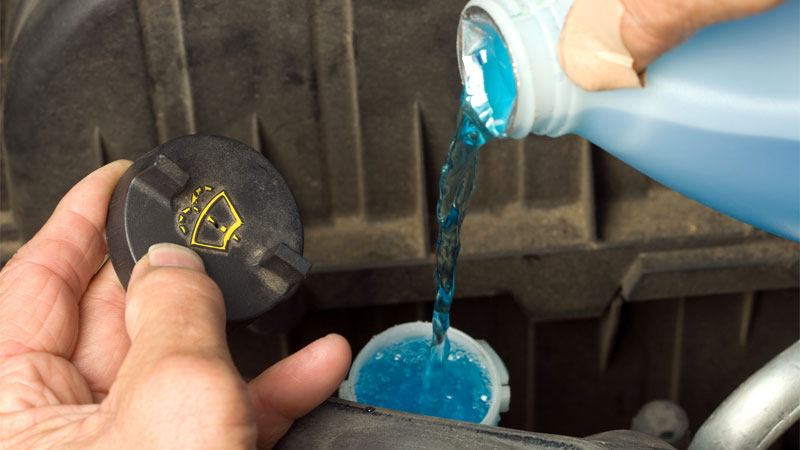
How do I know when the wiper fluid tank is full?
When refilling your windshield wiper fluid, most vehicles have a fill line or a translucent reservoir, so you can easily see when it’s full. Be careful not to overfill, as it could lead to leaks and other issues. If your vehicle doesn’t have a visible fill line, simply fill the reservoir until it’s nearly full and leave some room for expansion.
Can water be used as a substitute for wiper fluid?
While water can technically be used as a substitute for wiper fluid in an emergency, it’s not recommended. Regular wiper fluid contains additives like detergents and antifreeze agents that help clean your windshield and ensure the fluid doesn’t freeze in colder temperatures.
Using solely water can reduce visibility, as it lacks these cleaning agents, and may lead to frozen lines or reservoirs in cold weather. But in summer, yes you can get away with adding some plain water but be sure you refill with actually washer fluid by the time cold temperatures start appearing.
What type of wiper fluid should I buy?
There are several types of windshield wiper fluids available, each formulated for different needs. Most standard wiper fluids work well for everyday use. However, if you live in an area with extreme temperatures, you may want to consider a de-icer wiper fluid for winter or bug-removing wiper fluid for summer. Always read the product description and check your vehicle’s owner’s manual for any specific recommendations.
Should I dilute the windshield wiper fluid with water?
Some wiper fluids come concentrated and require dilution, while others are pre-mixed and ready to use. Always read the instructions on the bottle to ensure you’re using the product correctly.
If the fluid is concentrated, follow the recommended dilution ratio to ensure optimal performance. Keep in mind that diluting pre-mixed fluids can reduce their effectiveness and potentially cause issues with your wiper system.

